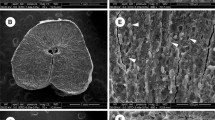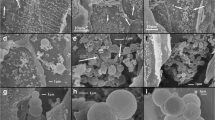Abstract
Modern Triticum dicoccum and Triticum aestivum grains, with and without glumes, were subjected to experimental carbonisation under anoxic conditions. Experimental variables were the presence or absence of glumes, temperature, exposure time and heating rate. The maximum temperature was 600°C, the time of exposure was 60 min and the heating rate between 1 and 100°C/min. Length, width, area, mass loss and reflectance of uncarbonised and carbonised grains were measured as a function of the variables. The main effects of charring are an increase in width, decrease in length and formation of protrusions. Reflectance measurements allow for the determination of the temperature at which carbonisation occurred. The occurrence of protrusions on the pericarp, longitudinal imprints in the pericarp and concave flanks are observed and discussed. The calculated shape factor 100L/W is a useful tool for distinguishing between T. dicoccum and T. aestivum grains in samples that contain at least thirty specimens, but for single grains this method is problematic.






Similar content being viewed by others
References
Boardman S, Jones G (1990) Experiments on the effects of charring on cereal plant components. J Archaeol Sci 17:1–11
Braadbaart F (2004) Carbonization of peas and wheat. A laboratory study. Doctoral thesis, University of Leiden. www.amolf.nl/publications/theses
Braadbaart F, van Bergen PF (2005) Digital imaging analysis of size and shape of wheat and pea upon heating under anoxic conditions as a function of the temperature. Veget Hist Archaeobot 14:67–75
Braadbaart F, van der Horst J, Boon JJ, van Bergen PF (2004) Laboratory simulations of the transformation of emmer wheat as a result of heating: the change of the physical, bulk chemical and molecular composition. J Therm Anal Calorim 77:957–973
Braadbaart F, Bakels CC, Boon JJ, van Bergen PF (2005) The selection of a variety of emmer wheat for heating experiments under anoxic conditions. Archaeometry 47:101–112
Braadbaart F, Wright PJ, van der Horst J, Boon JJ (2006) A laboratory simulation of the carbonization of sunflower achenes and seeds. J Anal Appl Pyrolysis 78:316–327
Carr AD, Williamson JE (1989) The relationship between aromaticity, vitrinite reflectance and maceral composition of coals: implications for the use of vitrinite reflectance as a maturation parameter. Adv Org Geochem 6:313–323
Hillman G (2001) Archaeology, percival, and the problems of identifying wheat remains. In: Caligari PDS, Brandham PE (eds) Wheat taxonomy: the legacy of John Percival. Linnean Society, London. Linnean Special Issue 3:27–36
Hillman GC, Mason S, de Moulins D, Nesbitt M (1996) Identification of archaeological remains of wheat: the 1992 London workshop. Circaea 12:195–209
Hopf M (1955) Formveränderungen von getreidekörnern beim verkohlen. Ber Dtsch Bot Ges 68:191–193
Hubbard RNLB (1992) Dichotomous keys for the identification of the major old world crops. Rev Palaeobot Palynol 73:105–115
International standard ISO 7404–2 (1985) Methods for the petrographic analysis of bituminous coal and anthracite. Part 2: method of preparing coal samples, ref. no. ISO 7404/2-1985(E)
International standard ISO 7404-5 (1994) Methods for the petrographic analysis of bituminous coal and anthracite. Part 5: method of determining microscopically the reflectance of vitrinite, ref. no. ISO 7404/5-1994(E)
Maier U (1996) Morphological studies of free-threshing wheat ears from a Neolithic site in southwest Germany, and the history of the naked wheats. Veget Hist Archaeobot 5:39–55
Papa C (1995) The “farre de Montelione”: landrace and representation. In: Padulosi S, Hammer K, Heller J (eds) From staple crop to extinction? The archaeology and history of the hulled wheats. Hulled wheats. Proceedings of the first international workshop on hulled wheats. International Plant Genetic Resources Institute, Rome, pp 154–168
Acknowledgments
This article is dedicated to Professor Corrie Bakels on the occasion of her 65th birthday. The author wishes to express his gratitude to her for introducing him to this research and for stimulating discussions. The comments of L.I. Kooistra (Zaandam) and M. Nesbitt (London), which led to a significant improvement of the text, are greatly appreciated.
Author information
Authors and Affiliations
Corresponding author
Rights and permissions
About this article
Cite this article
Braadbaart, F. Carbonisation and morphological changes in modern dehusked and husked Triticum dicoccum and Triticum aestivum grains. Veget Hist Archaeobot 17, 155–166 (2008). https://doi.org/10.1007/s00334-007-0134-6
Received:
Accepted:
Published:
Issue Date:
DOI: https://doi.org/10.1007/s00334-007-0134-6




